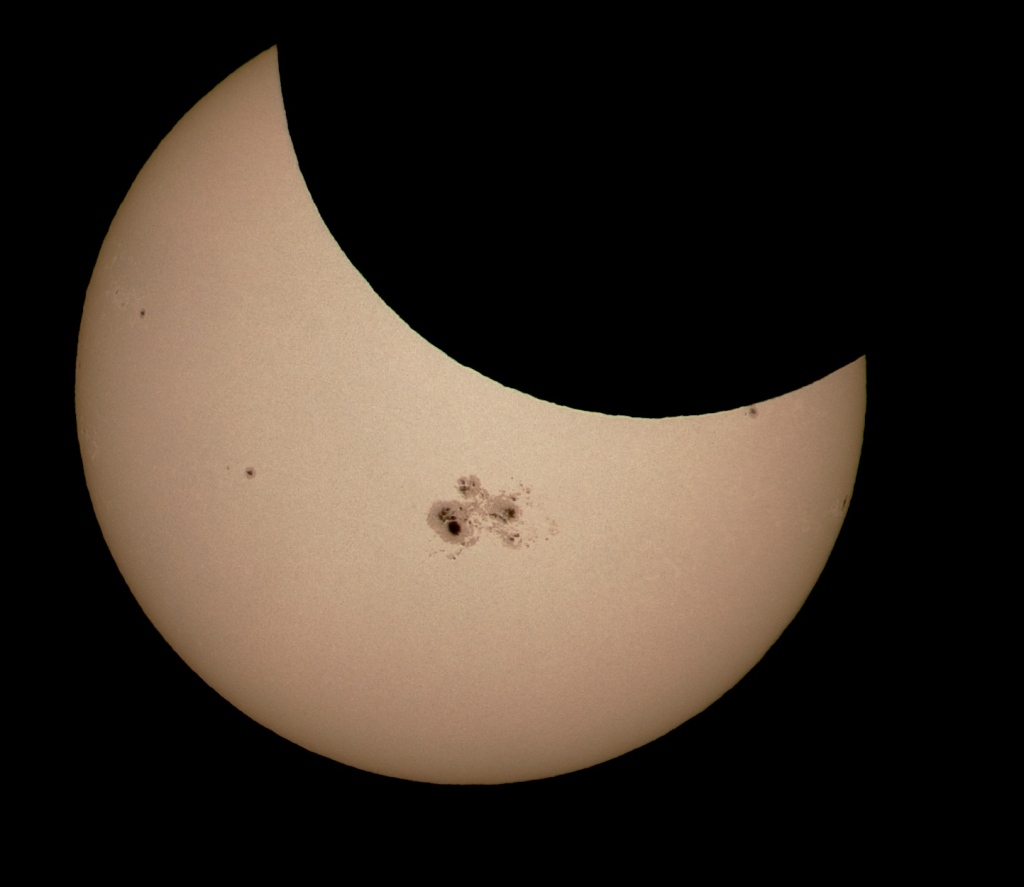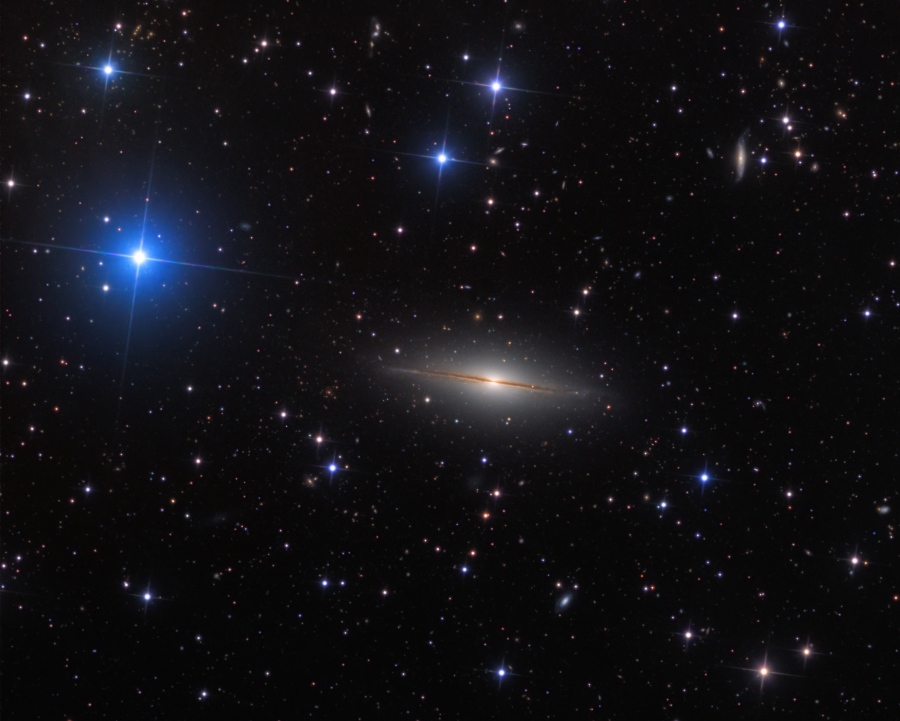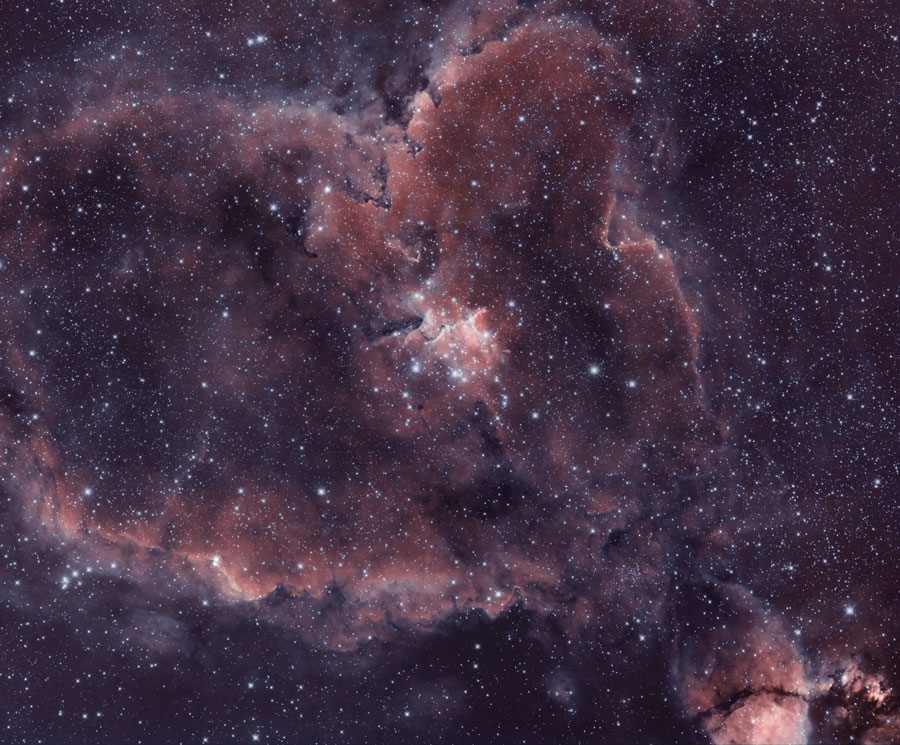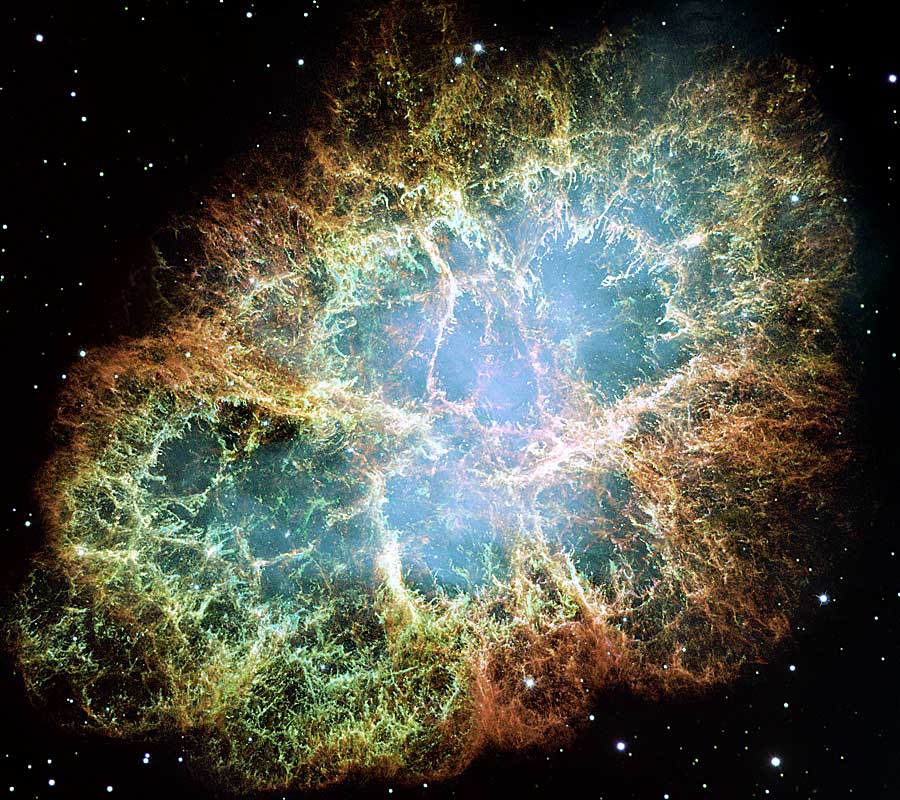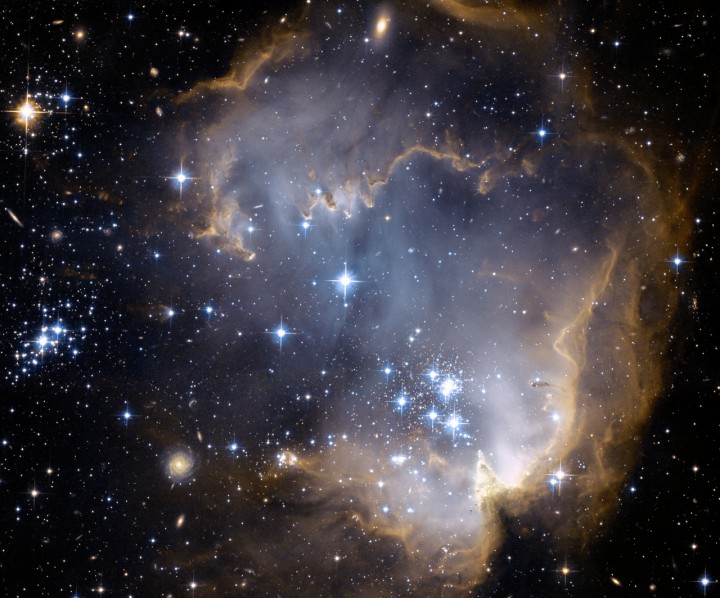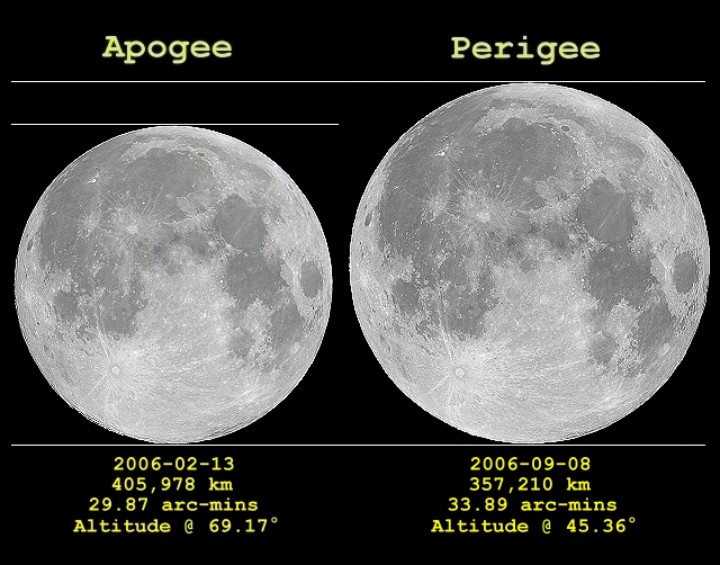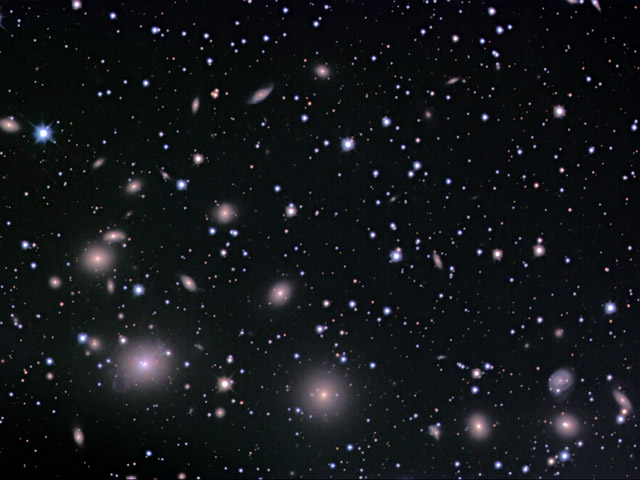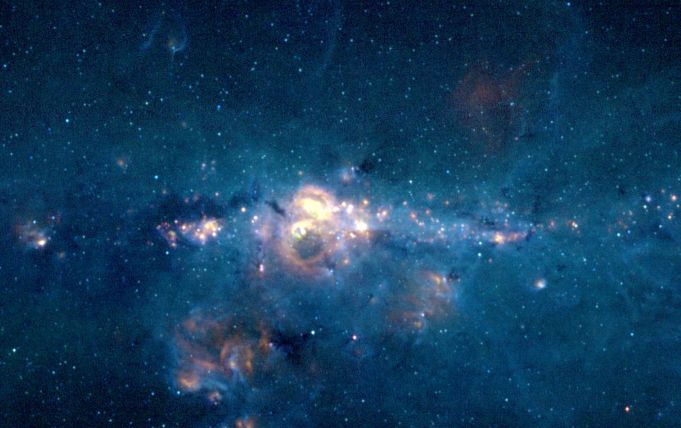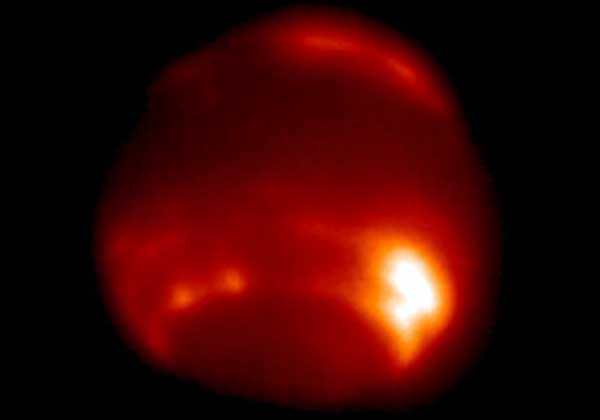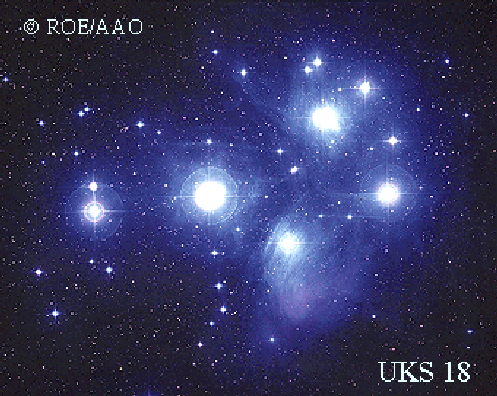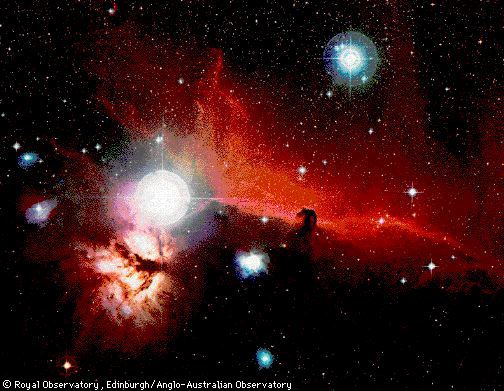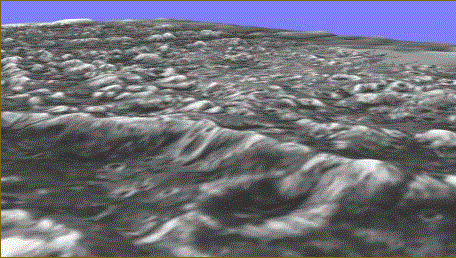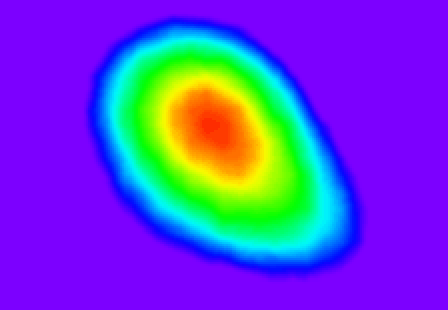| << Previous | Index | Next >> |
2014 A New Moon joined giant sunspot group AR 2192 to dim the bright solar disk during Thursday's much anticipated partial solar eclipse. Visible from much of North America, the Moon's broad silhouette is captured in this extreme telephoto snapshot near eclipse maximum from Santa Cruz, California. About the size of Jupiter, the remarkable AR 2192 itself darkens a noticeable fraction of the Sun, near center and below the curved lunar limb. As the sunspot group slowly rotates across the Sun and out of view in the coming days its activity is difficult to forecast. But the timing of solar eclipses is easier to predict. The next will be a total solar eclipse on March 20, 2015.
2013
2012 Braided, serpentine filaments of glowing gas suggest this nebula's popular name, The Medusa Nebula. Also known as Abell 21, this Medusa is an old planetary nebula some 1,500 light-years away in the constellation Gemini. Like its mythological namesake, the nebula is associated with a dramatic transformation. The planetary nebula phase represents a final stage in the evolution of low mass stars like the sun, as they transform themselves from red giants to hot white dwarf stars and in the process shrug off their outer layers. Ultraviolet radiation from the hot star powers the nebular glow. The Medusa's transforming star is near the center of the overall bright crescent shape. In this deep telescopic view, fainter filaments clearly extend below and to the left of the bright crescent region. The Medusa Nebula is estimated to be over 4 light-years across.
2011 What powers the Heart Nebula? The large emission nebula dubbed IC 1805 looks, in whole, like a human heart. The nebula glows brightly in red light emitted by its most prominent element: hydrogen. The red glow and the larger shape are all created by a small group of stars near the nebula's center. A close up in high dynamic range (HDR) spanning about 30 light years contains many of these stars is shown above. This open cluster of stars contains a few bright stars nearly 50 times the mass of our Sun, many dim stars only a fraction of the mass of our Sun, and an absent microquasar that was expelled millions of years ago. The Heart Nebula is located about 7,500 light years away toward the constellation of Cassiopeia.
2010 Is there enough water on the moon to sustain future astronauts? The question has important implications if humanity hopes to use the Moon as a future outpost. Last year, to help find out, scientists crashed the moon-orbiting LCROSS spacecraft into a permanently shadowed crater near the Moon's South Pole. New analyses of the resulting plume from Cabeus crater indicate more water than previously thought, possibly about six percent. Additionally, an instrument on the separate LRO spacecraft that measures neutrons indicates that even larger lunar expanses -- most not even permanently shadowed -- may also contain a significant amount of buried frozen water. Pictured above from LRO, areas in false-color blue indicate the presence of soil relatively rich in hydrogen, which is thought likely bound to sub-surface water ice. Conversely, the red areas are likely dry. The location of the Moon's South Pole is also digitally marked on the image. How deep beneath the surface the ice crystals permeate is still unknown, as well as how difficult it would be to mine the crystals and purify them into drinking water.
2009 This is the mess that is left when a star explodes. The Crab Nebula, the result of a supernova seen in 1054 AD, is filled with mysterious filaments. The filaments are not only tremendously complex, but appear to have less mass than expelled in the original supernova and a higher speed than expected from a free explosion. The above image, taken by the Hubble Space Telescope, is presented in three colors chosen for scientific interest. The Crab Nebula spans about 10 light-years. In the nebula's very center lies a pulsar: a neutron star as massive as the Sun but with only the size of a small town. The Crab Pulsar rotates about 30 times each second.
2008 Near the outskirts of the Small Magellanic Cloud, a satellite galaxy some 200 thousand light-years distant, lies 5 million year young star cluster NGC 602. Surrounded by natal gas and dust, NGC 602 is featured in this stunning Hubble image of the region. Fantastic ridges and swept back shapes strongly suggest that energetic radiation and shock waves from NGC 602's massive young stars have eroded the dusty material and triggered a progression of star formation moving away from the cluster's center. At the estimated distance of the Small Magellanic Cloud, the picture spans about 200 light-years, but a tantalizing assortment of background galaxies are also visible in the sharp Hubble view. The background galaxies are hundreds of millions of light-years or more beyond NGC 602.
2007 Tonight, those blessed with clear skies can enjoy a glorious Full Moon, (exact full phase at 0452 UT, October 26). In fact, the Moon will reach its full phase within a few hours of perigee, the closest point in its elliptical orbit, making it the largest Full Moon of 2007. On April 3, the Full Moon was within hours of apogee, the farthest point in the lunar orbit, corresponding to the smallest Full Moon of 2007. The difference in apparent size between the largest and smallest Full Moon is quite dramatic and similar to this side by side comparison of the lunar apogee/perigee apparitions from 2006. But seen in the sky many months apart, the change is difficult to notice. Skygazers should also enjoy the Moon on Saturday, October 27, as it encounters the lovely Pleiades star cluster. Because the Moon will be so bright, it will be easiest to spot the Pleiades stars near the Moon with binoculars or a small telescope.
2006 What caused that hole? The hole in question appears as a small dark circle on the far right. If the above image of aerogel seems dull and uninteresting, then welcome to one aspect of real world science. The interesting part is that something created that dark hole, and it might well be one of the first pieces of matter ever captured from outside our Solar System. Whatever created that hole was captured by the aerogel of the robotic Stardust spacecraft that flew across our Solar System for years and then returned a capsule to Earth. Scientists are now poring over the aerogel, looking to see what particles have become trapped. Many particles are surely from local Comet Wild 2, which Stardust flew past in 2004. Just a few particles, though, perhaps 10 or less, are expected to be from outside our Solar System. It is so difficult to find them that the Stardust team has created a downloadable interactive microscope program to allow anyone with a standard computer to help inspect aerogel slices and look for interstellar dust tracks. Good candidate tracks will later be inspected in great detail by members of the Stardust team.
2005
2004 Here is one of the largest objects that anyone will ever see on the sky. Each of the fuzzy blobs in the above picture is a galaxy, together making up the Perseus Cluster, one of the closest clusters of galaxies. The cluster is seen through the foreground of faint stars in our own Milky Way Galaxy. It takes light roughly 300 million years to get here from this region of the Universe, so we see this cluster as it existed before the age of the dinosaurs. Also known as Abell 426, the center of the Perseus Cluster is a prodigious source of X-ray radiation, and so helps astronomers explore how clusters formed and how gas and dark matter interact. The Perseus Cluster of Galaxies is part of the Pisces-Perseus supercluster of galaxies, which spans over 15 degrees and contains over 1000 galaxies.
2003 Awash in a sea of plasma and anchored in magnetic fields, sunspots are planet-sized, dark islands in the solar photosphere, the bright surface of the Sun. Before the enlightened(!) age of cameras, solar observers created detailed drawings of sunspots as they changed and progressed across the visible solar disk. But contemporary observers also regularly use this time-honored method of monitoring sunspots. In this sketch from March 6th 2001, astronomer Gunther Groenez has faithfully recorded the intriguing shapes and shades of major visible sunspot groups and labeled them according to their NOAA active region number. Solar north is up and east to the right. Groenez' technical equipment includes H and 2H pencil leads for the sunspot umbra (dark) and penumbra (light) areas respectively. Want to draw sunspots too? Now's your chance as two large sunspot groups are presently making their way across the solar disk. Activity associated with these large sunspots may trigger aurora in the coming days.
2002 In Jules Verne's science fiction classic A Journey to the Center of the Earth, Professor Hardwigg and his fellow explorers encounter many strange and exciting wonders. What wonders lie at the center of our Galaxy? Astronomers know of some of the bizarre objects which exist there, like vast cosmic dust clouds, bright star clusters, swirling rings of gas, and even a supermassive black hole. Much of the Galactic Center is shielded from our view in visible light by the intervening dust and gas, but it can be explored using other forms of electromagnetic radiation. This haunting wide angle image of the Galactic Center region in infrared light was constructed using data from the Midcourse Space Experiment (MSX) satellite. The image maps three mid-infrared bands, otherwise invisible to human eyes, into visible blue, green, and red colors revealing the thermal emission from dust clouds near the galactic center that have been heated by starlight. The galactic plane runs along the middle of this image while the galactic center itself is the bright spot at picture center. The field of view of this cropped picture is about 1.5 by 2.5 degrees.
2001 After an interplanetary journey lasting 200 days, the Mars Odyssey spacecraft has entered orbit around the Red Planet. This latest success is welcome as in the past, Mars has often seemed a difficult planet to visit. Beginning with the first Soviet attempts in 1960, around 30 missions have tried while only 10 or so have gone without serious mishap. Now that Mars Odyssey has arrived, its immediate future will involve aerobraking. Cautiously dipping into the martian atmosphere, the spacecraft will gradually adjust its present wide and elliptical 20-hour orbit to a circular 2-hour orbit only 400 kilometers above the planet's surface. Then, its instruments and cameras will focus on exploring the climate and geologic history of Mars, including the search for water and evidence of life-sustaining environments. In the artist's conception above, the spacecraft with wing-like solar panels is imagined firing its rocket engine for Mars orbit insertion over terrain seen in natural and false-color.
2000 The lonely RX J1856.5-3754 was formed from the collapsed core of an exploding star. At a distance of 180 light-years it is the closest known neutron star. More massive than the Sun but only 20 kilometers across, this tiny stellar juggernaut plows through the hydrogen gas and dust clouds of interstellar space at about 200 kilometers per second. The surface of the neutron star is fantastically hot, around 700,000 degrees Celsius, making it detectable with orbiting x-ray telescopes. But optical astronomers were recently surprised to discover that RX J1856.5-3754 is also surrounded by a cone-shaped nebula. Indicated in this deep image from the European Southern Observatory's Kueyen telescope, the nebula glows in the red light of ionized hydrogen atoms recombining with electrons. Its cone shape is analogous to the bow wave of a ship plowing through water. A faint blue dot near the tip of the cone is the neutron star itself. The nebula appears to have formed very near the surface of the neutron star and astronomers are trying to determine if the observed densities and temperatures can indeed explain the nebula's appearance.
1999 Neptune has never looked so clear in infrared light. Neptune is the eighth most distant planet from the Sun, thirty times the Earth-Sun distance. Neptune is the fourth largest planet, almost four times Earth's diameter. Surprisingly, Neptune radiates about twice as much energy as it receives from the Sun. A fascinating feature of the above photograph is that it was taken far from distant Neptune, through the Earth's normally blurry atmosphere. The great clarity of this recently released image was made possible by "rubber mirror" adaptive optics technology. Here, mirrors in the new Palomar High Angular Resolution Observer (PHARO) instrument connected to the 200-inch Hale Telescope flex to remove the effects of turbulence in the Earth's atmosphere.
1998 It is the most famous star cluster on the sky. The Pleiades can be seen without binoculars from even the depths of a light-polluted city. Also known as the Seven Sisters and M45, the Pleiades is one of the brightest and closest open clusters. The Pleiades contains over 3000 stars, is about 400 light years away, and only 13 light years across. Quite evident in the above photograph are the blue reflection nebulae that surround the bright cluster stars. Low mass, faint, brown dwarfs have recently been found in the Pleiades.
1997 The Horsehead Nebula is one of the most famous nebulae on the sky. It is visible as the black indentation to the red emission nebula seen just to the right of center of the above photograph. The bright star near the center is located in the belt of the familiar constellation of Orion. The horse-head feature is dark because it is really an opaque dust cloud which lies in front of the bright red emission nebula. Like clouds in Earth's atmosphere, this cosmic cloud has assumed a recognizable shape by chance. After many thousands of years, the internal motions of the cloud will alter its appearance. The emission nebula's red color is caused by electrons recombining with protons to form hydrogen atoms. Also visible in the picture are blue reflection nebulae, which preferentially reflect the blue light from nearby stars.
1996 This is what it would look like to fly over the surface of Jupiter's moon Ganymede. NASA's robot spacecraft Galileo recently approached only 6000 miles from this frozen ice-ball of a moon. The above image is a digital reconstruction from two images taken during this flyby. The blue color of the sky is artificial. Deep furrows cover Ganymede's surface, and several impact craters are also present. Galileo continues to orbit Jupiter and send back breathtaking photos of Ganymede, Io, Europa, Callisto, and, of course, Jupiter itself.
1995 Solar flares are propelled high above the Sun's surface by powerful, twisted magnetic fields. The flares spew high energy atomic and subatomic particles into space. During an intense solar flare on June 15, 1991, a spray of solar neutrons was detected by the COMPTEL instrument onboard NASA's Compton Gamma Ray Observatory. Like paint from a spray can, the neutrons formed the above image (seen in false color) on the COMPTEL detectors. Such astronomical images made by high energy particles are unusual, astronomers typically use visible light and other forms of electromagnetic radiation to study the Universe. High energy particles from solar flares affect the Earth and near Earth environment so solar activity is constantly monitored.
| << Previous | Index | Next >> |
